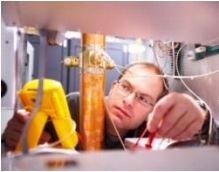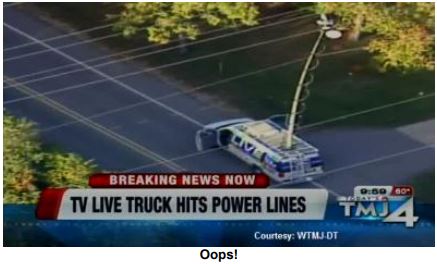Staying Safe Around ENG Trucks

[October 2010] Radio and television remote trucks often use microwave transmitters to get the program material back to the studio. Whether using a fixed antenna that needs to be mounted or one of those power masts to raise and lower them, care must be taken. Otherwise accidents – even fatalities – can occur too easily. Tom May offers some thoughts on staying safe.
For television viewers in the Milwaukee area, the sight of a local station’s ENG truck tangled in power lines seemed almost comical. That is because for the third time in five years, this particular station has been involved in a dangerous accident.
But for Milwaukee broadcast engineers, it is far from a laughing matter.
Safety is Serious Business
Periodically, we hear or see reports from around the country about an ENG truck that hit a power line and burned or exploded, seriously injuring or killing one or more occupants. Each such incident is a reminder that – especially with staff turnover – an ongoing, serious safety program is necessary at all stations with such gear.
Fortunately, no one was killed in the Milwaukee incidents. However, with just a slight difference in conditions, a tragedy could have occurred.
The first incident occurred in 2005 when the truck struck power lines, causing the mast to break. Then, in 2007, the truck was being driven on a frozen lake when it broke through thin ice.
Most recently it was another power line incident occurring the evening of September 30th, 2010. The driver of the ENG van apparently drove off from the scene where the crew had been conducting a segment on highway construction. The mast was still fully extended.

You can see the full story online.
One could argue about the details that led to these accidents, but one thing is for certain: ENG safety and training should be a priority for any station that maintains such vehicles.
Stop Accidents Before They Happen
What can be done to prevent mast-related accidents? What follows is a sort of checklist of the areas that should have your attention – and that of anyone who uses the station ENG vehicles.
- Training, Training, Training!
First and foremost: establish an in-house training program that is conducted on a regular basis. All ENG drivers should be required to attend a certain number of these sessions annually and pass a written test as well as a simple operations test in the parking lot. Anyone who needs additional help should work with another operator until they can demonstrate the necessary safety skills.
The same procedure should be in place for any new hires before they are allowed to take the vehicle into the field. ENG vehicles are now governed by OSHA, so make sure you and your field personnel are in compliance with OSHA regulations relevant to your operation.
- Interlocks
Motorized masts can sometimes be interlocked with the vehicle itself.
Many vehicles with automatic transmissions will not permit the gear selector to be moved out of “Park” without the brake being depressed. This is typically done with an electronic solenoid tied to the brake lamp circuit. If your vehicle posses this type of setup, consider putting an interlock switch in series with the shift solenoid so that the vehicle cannot be physically put into gear with the mast in an extended position.
- Alarms
Even the simplest form of safety system should include some type of alarm or warning light that the mast is extended – such as a lamp mounted to the dash board that is impossible to ignore when illuminated. I have seen several stations use semi-trailer side marker lamps for this purpose.
Also, consider investing in a high voltage proximity sensor. Several manufacturers make these devices and they are widely used in the lineman industry. A sensor can be mounted on the top of the mast to alert the operator of overhead lines, and some models can even be interlocked with the mast motor, thereby stopping extension of the mast if overhead lines are detected.
- Remote Controls
Provide raise and lower controls in a location that requires the user to be outside the vehicle when operating the mast. Operators are less likely to have an accident if they have to physically watch it go up and down. Monitoring by camera helps, but it only gives you a small window of your surroundings.
- Signage
Make sure your vehicle has signage in all key areas that alert operators to the dangers, as well as OSHA regulations. The last thing you want is someone to say they were unaware of the danger.
- Emergency Procedures
Just as you have disaster preparedness plans for your facility (you do have those, right?) you should also have plans available in the trucks with procedures for common emergencies. Should your operators find themselves tangled in the lines, they need to know what to do to keep themselves alive. Work with your local power company to make sure your procedures make sense and are accurate.
- Do not just stop at the mast
Make sure all the other vehicle safety items are inspected and working. This includes checking seat belts, air bags, tire pressure, brakes, power steering and exterior lights. Another overlooked item is generator exhaust. If there is any doubt about exhaust fumes entering the cabin of the vehicle, get an exhaust hose and make the operators use it!
- Informed Management
Work with the GM and News Director to establish procedures where operators are encouraged to report safety issues with the vehicle. A vehicle with a known safety problem should not be allowed to go into the field until repaired – no excuses, no story or remote broadcast is worth endangering someone!
– – –
Tom May is Chief Engineer for WUWM-FM, Milwaukee Public Radio. Contact Tom at tmay@uwm.edu
